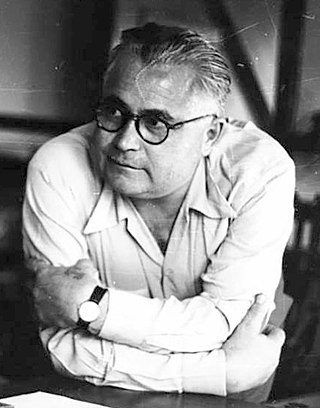Top Qs
Timeline
Chat
Perspective
Vladimir Petrov (diplomat)
Soviet intelligence officer (1907–1991) From Wikipedia, the free encyclopedia
Remove ads
Vladimir Mikhaylovich Petrov (Russian: Влади́мир Миха́йлович Петро́в; born Afanasii Mikhailovich Shorokhov; 15 February 1907 – 14 June 1991) was a Soviet spy who defected to Australia in 1954 with his wife Evdokia, in what became known as the Petrov Affair.
Remove ads
Early life and career
Petrov was born Afanasii Mikhailovich Shorokhov (Russian: Афанасий Миха́йлович Шорохов) on 15 February 1907 in Larikha, Russia, in what is now Tyumen Oblast in central Siberia.[1]
Petrov was one of three brothers born to a peasant family. His father died when he was seven years old and he started work at a young age to support his family. He had only three years of formal education and was apprenticed to a blacksmith at the age of fourteen.[1]
In 1923, Petrov established a local Komsomol cell. He subsequently joined the Soviet Navy's cryptographical section where he was a specialist in ciphers. He changed his full name to Vladimir Mikhaylovich Proletarsky (Russian: Влади́мир Миха́йлович Пролетарский) in 1929, naming himself after the proletariat.[1]
Remove ads
Intelligence career
Summarize
Perspective
Petrov decided to join the Soviet spy organization, then called the OGPU, in May 1933, while serving in the Navy. He was subsequently admitted to the Special Cipher Section, which was attached to the Foreign Department of the OGPU. His memoir makes clear that his status in this section allowed him to learn many Soviet secrets by reading the top secret ciphers.
Petrov's joint memoir with his wife Evdokia Petrov's joint memoir, Empire of Fear, gives the following details about his career between 1930 and 1954.[2] The book, Empire of Fear, was ghost-written by an ASIO intelligence officer, Michael Thwaites, serialised in newspapers in 1955, and published in book-form in 1956.[3]
- 1930–1933 cypher clerk Soviet Navy.
- 1933–1937 NKVD Moscow dealing with overseas cypher communications.
- 1937 NKVD cypher clerk attached to Soviet Army Western China.
- 1940–1942 NKVD cypher clerk Moscow dealing with Internal communications.
- 1942–1947 NKVD cypher clerk Sweden with additional Internal Security duties.
- 1947–1951 MGB Moscow handling cases of Soviet seamen accused of offences while visiting foreign ports.
- 1951–1954 MGB controller in Australia. Having graduated from cipher clerk to full-fledged agent, Petrov was sent to Australia in 1951. His job there was to recruit spies and to keep watch on Soviet citizens, making sure that none of the Soviets abroad defected.
Petrov lived through the purges of Stalin under Yagoda, Yezhov, and Beria. Even though a great number of his friends, colleagues, and superiors were arrested and executed, Petrov escaped unscathed.[4]
Remove ads
Defection
Petrov's defection came about through his association with Polish-born doctor and musician Michael Bialoguski, who played along in seeming to allow Petrov to recruit him to gather information, while at the same time reporting to Australian Security Intelligence Organisation on Petrov's activities.
Petrov applied for political asylum in 1954, on the grounds that he could provide information regarding a Soviet spy ring operating out of the Soviet Embassy in Australia. Petrov states in his memoirs that his reasoning for defecting lay not in an imminent fear of being executed, but in his disillusionment with the Soviet system and his own experiences and knowledge of the terror and human suffering inflicted on the Soviet people by their government, in particular during the forced collectivization of farms and the famine which resulted.
Later life
Summarize
Perspective
Petrov and his wife were granted Australian citizenship on 12 October 1956. The government imposed a D-Notice, barring reporting of their activities, and established them in a safe house in Bentleigh East over fears that the Soviet government would attempt their assassination.[1] He and his wife adopted the pseudonyms of Sven and Anna Allyson to protect their identities.[5] Although the press agreed not to identify them under the D-notice, the press did not always observe this voluntary protection order. The whereabouts of the Petrovs were still the subject of a D-Notice in 1982.[6][7]
In 1957, under his assumed identity, Petrov began working for Ilford Photo in Upwey, while his wife worked as a typist for a tractor company.[1] They purchased a house in Bentleigh, living a quiet suburban life.[5] Petrov "enjoyed Australian rules football and rabbit shooting" while his wife did voluntary work for Meals on Wheels.[1]
Petrov suffered a series of strokes in 1974 and was hospitalised at the Mount Royal Geriatric Hospital in Parkville (now part of Royal Melbourne Hospital). He remained hospitalised until his death from pneumonia on 14 June 1991, aged 84. A private funeral was held, "attended only by his wife, a few friends, and ASIO officers" including former director-general Charles Spry.[1]
Remove ads
Fictional representations
Petrov's defection has inspired fictional works.
- The Case of Colonel Petrov (1956) for American television
- Defection! The Case of Colonel Petrov (1966) for British television
- The Red Shoe, a novel by Ursula Dubosarsky which won the New South Wales Premier's Literary Award and the Queensland Premier's Literary Award in 2006.[8]
- Mrs Petrov's Shoe, a play by Noelle Janaczewska which won the Queensland Premier's Literary Award for drama in 2006.[8]
- The Safe House, an animation by Lee Whitmore, narrated by Noni Hazelhurst, which won Best Animation at the Sydney Film Festival 2006.[9]
- Document Z, a novel by Andrew Croome, which won the Australian/Vogel Literary Award in 2008.[10]
- The Petrov Affair, a 1987 television mini-series.[11]
Remove ads
See also
References
Further reading
Wikiwand - on
Seamless Wikipedia browsing. On steroids.
Remove ads

